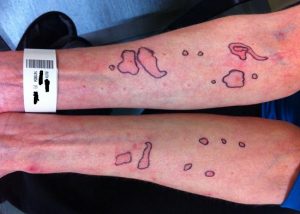If you have food, environmental or contact allergies, skin prick tests are one way of diagnosing what might be the culprit. They’re really quick and easy to perform but some people are are put off by the needle. Trust me, it’s not painful, but I know why some people get nervous.
What is an allergy skin prick test?
Tiny bits of allergens will be tested on your lower forearms, and here’s how they do it:
- First the allergy nurse will clean the area,
- Then place a drop of liquid with the allergen suspended in it onto the skin
- This is then pricked with a tiny needle and the watery substance is then wiped off.
- Each separate allergen was marked with biro with its initial e.g. w = walnuts, p = peanuts, a = almonds and
- Typically eight substances in total are tested, although this can vary: walnuts, peanuts, almonds, eggs, dairy, yeast, pine nuts and cashew nuts.
- After about 20 minutes the nurse will come to assess your reactions
- Each welt or hive, allergic reaction will be measured and recorded.
You should then see the specialist who will advise you how to proceed, and give you guidance of how to avoid your allergens if any have been identified.
Advice for preparing for allergy skin prick tests
Here’s some advice to help prepare you or your child for what’s coming!

- Arrive Early so that you can relax, get familiar with your surroundings
- Have a drink of water of tea/coffee to help calm your nerves if you’re worried
- Take a friend with you. If you accompany your child you can make sure they know they are going to be OK, that they will get a reward afterwards.
- Bring along sample foods if you suspect something unusual. The clinic should have most common allergens as sample to test from.
- Wrap any food samples you bring in in separate plastic bags or containers to avoid cross contamination.
- Bring your Food, Mood and Symptoms Diary with you if you have one.
- Just know is it almost disappearingly rare for anyone to have a serious reaction from skin prick tests as a tiny amount, almost invisible to the human eye is used.
- Know you are in a safe place. If you are worried, have your adrenaline ready and most importantly tell staff if you are scared.
- Use distraction techniques with children. The good allergy nurses will talk gently as they go about preparing the needle to test, just chatting, singing even maybe. Pat the arm, tickle the arm, just make it a bit of a game and they shouldn’t be too bothered by the skin prick. It’s over so fast.
My allergy skin prick tests were not what I was expecting!
I was feeling quite optimistic and interested in what this visit might hold. Guidance and reintroduction of said nasties was high on my agenda. I had yet to begin trying to eat egg again since my last anaphylactic attack – caused after eating smoked salmon and scrambled eggs in a local pub. I ended up in A&E and had to use my EpiPen for the first time; a very terrifying experience. The doctors thought it could have been caused by loosely cooked egg and I was advised to eat a hard boiled egg and see what happened but the prospect of this little experiment filled me with dread.
I had been planning to try egg for weeks but kept putting it off; it had to be a day when I was not alone and had someone with me to help and act fast in case anything happened.
I was allergic to dairy, not eggs!
Twenty minutes later and some of the tests had risen into ugly hard watery filled nettle rash reactions which were very itchy. Not surprisingly I had a strong reaction to peanuts, cashew nuts and almonds; I knew the nuts would be a problem but didn’t expect to discover that I now have an actual confirmed allergy to dairy too. I had always suspected that I had an intolerance but the reaction for dairy was stronger than those to the nuts.
Pine nuts, yeast and eggs were all OK so I now knew that those scrambled eggs most definitely didn’t cause anaphylaxis, but the butter and milk they were cooked with were confirmed as the culprits. Since I had some quite strong reactions, I was advised to leave the other foods to test on another day. These tests only identify real allergic reactions, they do not show mild or intolerant type reactions as these can take hours or even days for the body to react.
Getting a referral to a dietician
With my confirmed list of allergies I was referred to Tanya Wright, Dietician at Amersham Dermatology department. She has opened up a whole new world to me. With her help I have now successfully begun to reintroduce foods which cause an intolerant reaction one by one, and am also discovering a whole host of different foods that I could be eating. She has a library of food packets and samples in her room which are dairy free, soya free, gluten free etc.; there are so many more foods out there that I can eat and I can’t wait to try them all. My mouth was watering with anticipation.
Visit the National Library of Medicine for an explanation of what is involved with Skin Prick Tests.












Leave a Reply